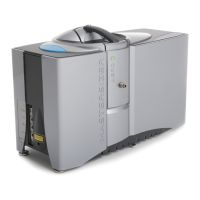Hardware features
41
Drip tray
Any overspills are captured within the drip tray and drained through a drain port at the
front of the cell and optical unit. If any liquid is noticed in the drip tray, remove the cell
and tip the contents away. Locate and fix any leaks.
Pipette entry
Note: Insert the pipette fully before injecting sample. Do not drip sample into
the top of the pipette entry hole.
The pipette entry enables you to add sample to the cuvette at the required obscuration
range once the SV cell has been inserted into the cell bay of the optical unit.
The internal pipette guide is curved to ensure the pipette is positioned above the cuvette
opening, and to prevent any escape of laser light during sample addition.
l Insert the pipette until it stops, then add sample to the cuvette being careful not
to overfill it.
Note: The pipette must be removed once the sample is added.
Power and CAN connection
The CAN connection provides both the communications and power to operate the dis-
persion unit.
The CAN cable is connected from the CAN connection to one of the CAN connections on
the side of the optical unit.
Sample cuvette assembly
The sample cuvette is where the measurement of the sample is performed. The cuvette
windows allow the analyzer beam of the optical unit to pass through the cuvette and
hence the particle field. For optimum measurement analysis it is vital that the cuvette and
cuvette windows are kept clean of all residue.
A cuvette lid can be fitted to prevent any dust ingress into the cuvette, before placing the
cuvette into the SV cell.

